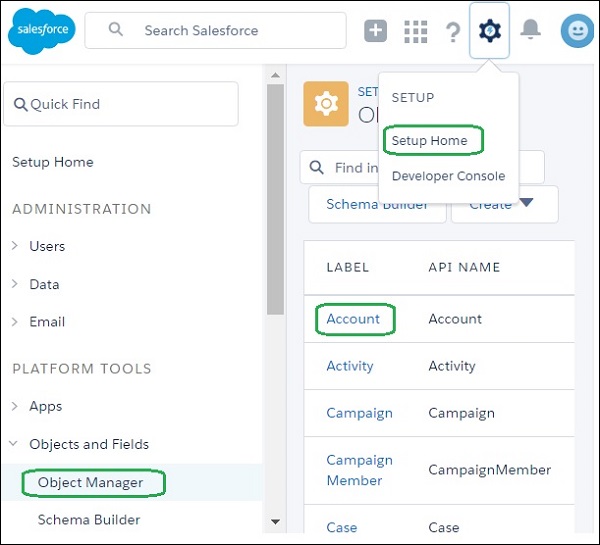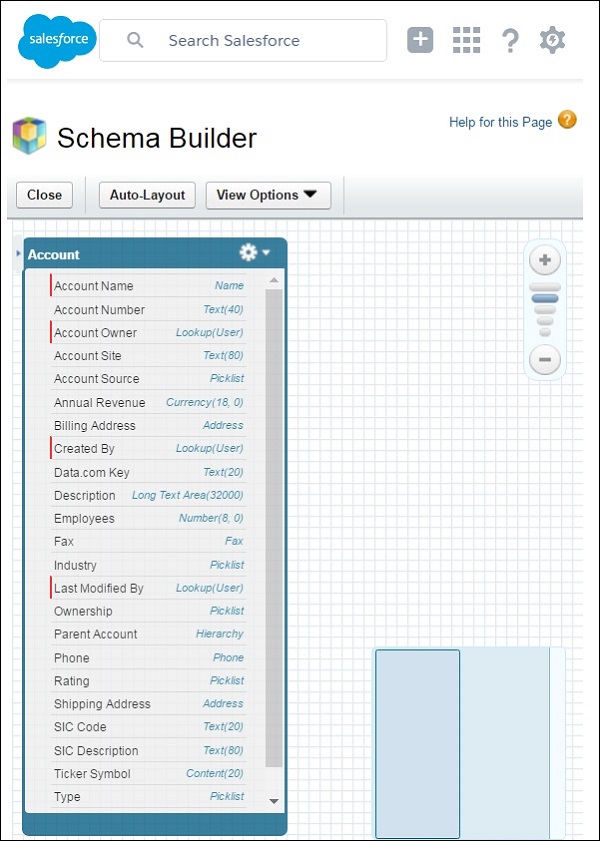
- Salesforce Tutorial
- Salesforce - Home
- Salesforce - Overview
- Salesforce - Architecture
- Salesforce - Environment
- Salesforce - Sales Cloud
- Salesforce - Service Cloud
- Salesforce - Navigating Setup
- Salesforce Objects
- Salesforce - Standard Objects
- Salesforce - Custom Objects
- Salesforce - Master Detail
- Salesforce - Lookup Relationship
- Salesforce - Schema Builder
- Data Security
- Salesforce - Control Access Org
- Salesforce - Control Access Objects
- Salesforce - Control Access Fields
- Salesforce - Control Access Records
- Salesforce - Create a Role Hierarchy
- Salesforce - Define Sharing Rules
- Process Builder
- Automate Business Processes
- Salesforce - Importing Data
- Salesforce - Exporting Data
- Salesforce - Reports
- Salesforce - Dashboards
- Salesforce - Using Formula Fields
- Visualforce
- Salesforce - Visualforce Pages
- Salesforce - Variables & Formulas
- Salesforce - Standard Controllers
- Salesforce - Records, Fields & Tables
- Salesforce - Using Forms
- Salesforce - List Controllers
- Salesforce - Static Resources
- Salesforce Useful Resources
- Salesforce - Quick Guide
- Salesforce - Useful Resources
- Salesforce - Discussion
Salesforce - Standard Objects
The Salesforce Platform stores data in relational tables. The records in these tables contain data for the structure of the platform itself as well as user created data. For example, the data about the configuration and settings of an account are already in-built as a relational table. But you can also create your own tables to store data specific to your business like the 'dispatch schedule' for a week assuming you are a courier company.
These relational tables are roughly referred to as API Objects or only objects in Salesforce. There are three kinds of Salesforce objects.
Standard Objects − The objects already created for you by the Salesforce platform.
Custom Objects − These are the objects created by you based on your business processes.
External Objects − The objects which you create map to the data stored outside your organization.
In this tutorial, we will focus on the standard objects in Salesforce platform.
Standard Objects
These are the objects which already exist in the Salesforce platform to manage the configurations and settings of the environment. Once you log in to the salesforce platform, you can see the available objects.
Example
The most commonly referred standard object is called the Account Object. It is the object which stores the preliminary information about a customer, partner, competitor or another organization. We can explore the account object by following the steps below.
Step 1
Login to the Salesforce platform and follow the link path Settings → Setup Home → Object Manager - Account.

Step 2
In this step, click on the Schema Builder. It shows the complete Account table with field names and data types. There are fields marked red. The fields marked red indicate that it is mandatory to fill the fields when an account is created.

Using the similar steps as above we can explore all the standard objects available.
Important Standard Objects
In this section, we will discuss the important standard objects in Salesforce. The following table lists down the objects −
| Object Name | Meaning | Usage |
|---|---|---|
| Account | Represents an individual account, which is an organization or person involved in the business like customers, competitors, partners, etc. | Use this object to query and manage accounts in your organization. |
| Account History | Represents the history of changes to the values in the fields of an account. | Use this object to identify changes to an account. |
| Case | Represents a case, which is a customer issue or problem. | Use the case object to manage cases for your organization. |
| Contact | Represents a contact, which is an individual associated with an account. | This object is used to manage individuals who are associated with an Account in the organization. |
| User | Represents a user in the organization. | This object is used to query information about users and also helps to provide and modify the information concerning the users. |
| Asset | Represents an item of commercial value, such as a product sold by the company or a competitor that a customer has purchased and installed. | This object is used to track assets previously sold into customer accounts. With asset tracking, a client application can quickly determine which products were previously sold or are currently installed at a specific account. |
| Domain | Read-only object that represents a custom Web address assigned to a site in your organization. | This read-only object is used to object to query the domains that are associated with each website in your organization. |